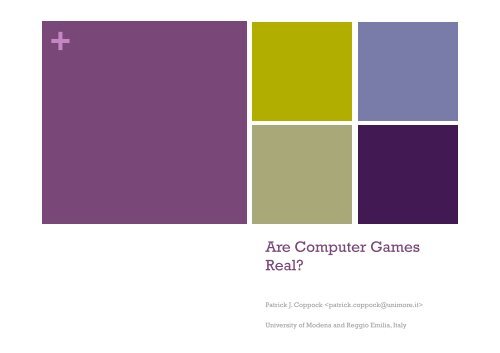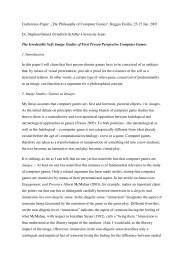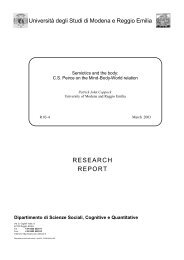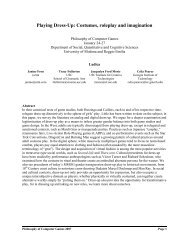Power Point slides
Power Point slides
Power Point slides
Create successful ePaper yourself
Turn your PDF publications into a flip-book with our unique Google optimized e-Paper software.
+Are Computer GamesReal?Patrick J. Coppock University of Modena and Reggio Emilia, Italy
+ Computer Games: Half-Real orReal? Jesper Juul (2005) suggests computer games are “half real”because: Playing computer games is a real world activity people take partin People feel involved with games and care about what happenswhen playing them Game-playing has (or may have) negotiable consequences in thereal world My question:So why can we not just say that computer games are “real”?
+ Big Question: OK. But what do we actually mean by“real”? Here: and first and foremost,”CulturalUnits”
+ Material Cultural Artefacts
+ Intangible Cultural Artefacts
+ Mediated Cultural Artefacts
+ Tangible, Intangible & MediatedCultural Artefacts
+ “Open” [Aesthetic] Works “Open works” are communicative strategies designed byauthors with an active interpretational role for their readersin mind (Eco 1984) “An open text cannot be described as a communicativestrategy if the role of its addressee (the reader in the case ofverbal texts) has not been envisioned as at the moment of itsgeneration” “The reader as an active principle of interpretation is a partof the picture of the generative process of the text.”
+ The Play of Intention in Text
+ Transmedia remediation
+ Speed Runs as Narrative Processes http://www.tv.com/uservideos/?search=speed+runs
+ Openness and Negotiation ofConsequences Juul (again): It is necessary to describe the relationship between thegame activity and the rest of the world, e.g. between: Game rules Variable and quantifiable outcomes of games Emotional attachments of players to various types of outcomes
+ Key sources and issues Sources: Player Experience Player Biographies Player Memory Issues: Player conjectures about, conceptions of, (past, present andfuture) actual and possible consequences for self and others. Narrower (more “local”) and broader (more “global”) pertinenceand identity issues
+ Factuality and Fiction The actual world as a cultural construct (Eco): The experienced world as a “multitude of world pictures orstated descriptions […] epistemic worlds that are frequentlymutually exclusive” Fictional possible worlds: “Small worlds”; “Handicapped worlds”; “Parasitical” on theactual world. “Constructed by human minds and hands”.
+ Beyond Culture “Even though the real world is a cultural construct, one mightstill wonder about the ontological status of the describeduniverse.
+ Self, Other and World as Process
+ Past, Present, Future Possibility andActuality
+ Intertwining Past, Present, FuturePossibility and ActualityPast Actualities Present Actualities Future ActualitiesPast Possibilities Present Possibilities Future Possibilities
+ Colin Powell Slides
+ Atom Egoyan
+ Orhan Pamuk
+ Elif Shahak
+ Kimveer Gill
+ Super Colombine Massacre RPG!
+ Dylan Klebold and Erik Harris
+ The Cultural Role of FictionalPossible Worlds Fictional characters live in a handicapped world. When weactually understand their fate, then we start to suspect thatwe too, as citizens of the actual world, frequently undergoour destiny just because we think of our world in the sameway as fictional characters think of their own. Fiction suggests that perhaps our view of the actual world isas imperfect as that of fictional characters. This is the way that successful fictional characters becomeparamount examples of the “real” human condition. (Umberto Eco)






